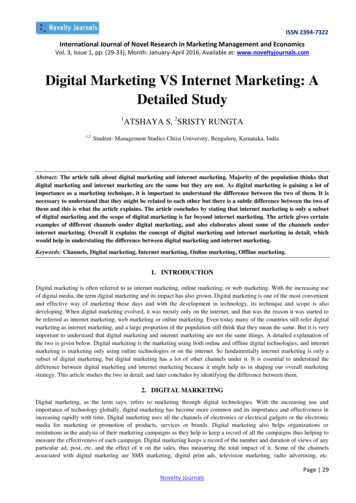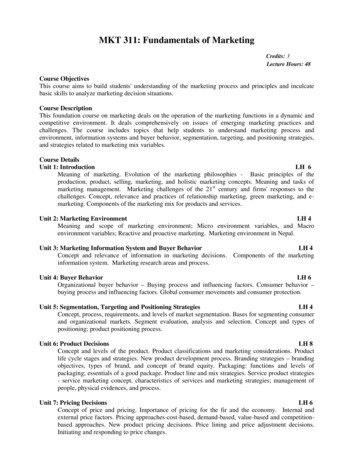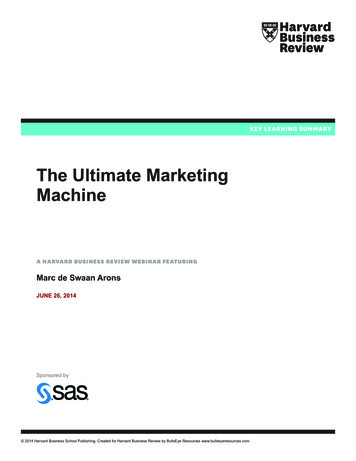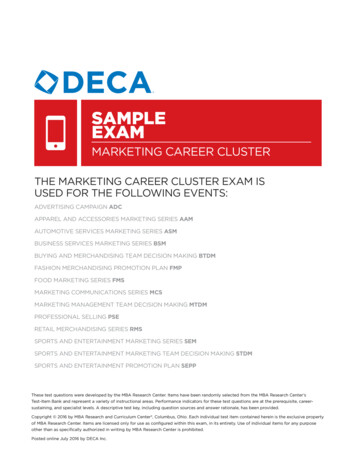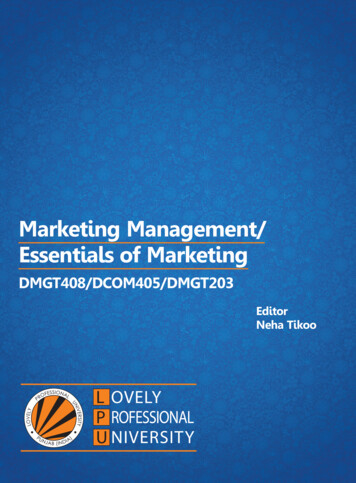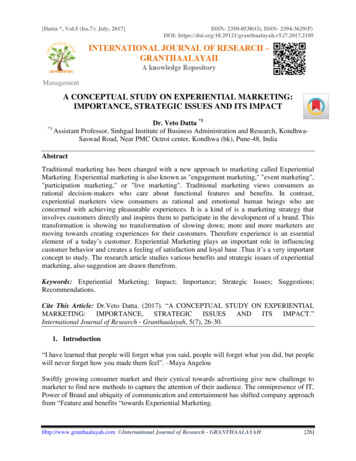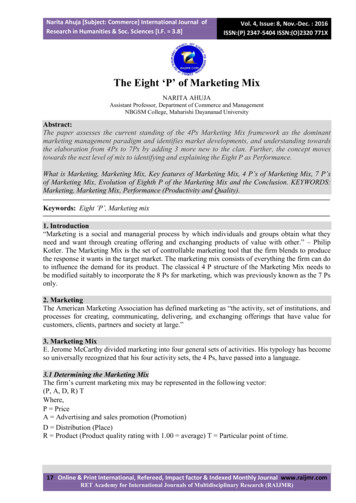
Transcription
Narita Ahuja [Subject: Commerce] International Journal ofResearch in Humanities & Soc. Sciences [I.F. 3.8]Vol. 4, Issue: 8, Nov.-Dec. : 2016ISSN:(P) 2347-5404 ISSN:(O)2320 771XThe Eight ‘P’ of Marketing MixNARITA AHUJAAssistant Professor, Department of Commerce and ManagementNBGSM College, Maharishi Dayananad UniversityAbstract:The paper assesses the current standing of the 4Ps Marketing Mix framework as the dominantmarketing management paradigm and identifies market developments, and understanding towardsthe elaboration from 4Ps to 7Ps by adding 3 more new to the clan. Further, the concept movestowards the next level of mix to identifying and explaining the Eight P as Performance.What is Marketing, Marketing Mix, Key features of Marketing Mix, 4 P’s of Marketing Mix, 7 P’sof Marketing Mix, Evolution of Eighth P of the Marketing Mix and the Conclusion. KEYWORDS:Marketing, Marketing Mix, Performance (Productivity and Quality).Keywords: Eight ‘P’, Marketing mix1. Introduction“Marketing is a social and managerial process by which individuals and groups obtain what theyneed and want through creating offering and exchanging products of value with other.” – PhilipKotler. The Marketing Mix is the set of controllable marketing tool that the firm blends to producethe response it wants in the target market. The marketing mix consists of everything the firm can doto influence the demand for its product. The classical 4 P structure of the Marketing Mix needs tobe modified suitably to incorporate the 8 Ps for marketing, which was previously known as the 7 Psonly.2. MarketingThe American Marketing Association has defined marketing as “the activity, set of institutions, andprocesses for creating, communicating, delivering, and exchanging offerings that have value forcustomers, clients, partners and society at large.”3. Marketing MixE. Jerome McCarthy divided marketing into four general sets of activities. His typology has becomeso universally recognized that his four activity sets, the 4 Ps, have passed into a language.3.1 Determining the Marketing MixThe firm’s current marketing mix may be represented in the following vector:(P, A, D, R) TWhere,P PriceA Advertising and sales promotion (Promotion)D Distribution (Place)R Product (Product quality rating with 1.00 average) T Particular point of time.17 Online & Print International, Refereed, Impact factor & Indexed Monthly Journal www.raijmr.comRET Academy for International Journals of Multidisciplinary Research (RAIJMR)
Narita Ahuja [Subject: Commerce] International Journal ofResearch in Humanities & Soc. Sciences [I.F. 3.8]Vol. 4, Issue: 8, Nov.-Dec. : 2016ISSN:(P) 2347-5404 ISSN:(O)2320 771X4. Key Features of Marketing Mix1. Interdependent variables: The marketing mix is made up of four unique variables. These fourvariables are interdependent and need to be planned in conjunction with one another to ensure thatthe action plans within all four are complimentary and aligned.2. Help Achieve Marketing Targets: Through the use of this set of variables, the company canachieve its marketing targets such as sales, profits, and customer retention and satisfaction.3. Flexible Concept: The marketing mix is a fluid and flexible concept and the focus on any onevariable may be increased or decreased given unique marketing conditions and customerrequirements.4. Constant Monitoring: It is vital to keep an eye on changing trends and requirements, within thecompany as well as in the market to ensure that the elements in marketing mix stays relevant andupdated.5. Role of Marketing Manager: A mature, intelligent and innovative marketing manager needs tobe at the helm of the marketing mix. This pivotal role means that this manager is responsible forachieving desired results through the skill manipulation of these variables.6. Customer as a focal point: A vital feature of the marketing mix is that the customer is the focalpoint of the activity. The value of the product is determined by customer perceptions and the goal isto achieve a satisfied and loyal customer.The 4Ps of marketing is a model for enhancing the components of ‘marketing mix’ – the way inwhich you take a new product or service to market. It helps you to define the marketing options interms of price, product, promotion, and place so that your offering meets a specific customer needor demand.5. The four ‘P’s are5.1 ProductProduct is anything that can be offered to market to satisfy a want or need, including physicalgoods, services, experiences, persons. It is a bundle of utilities or a cluster of tangible andintangible attributes. Product component of the marketing mix involves planning, developing, andproducing the right type of products and services. It deals with the dimensions of product line,durability, and other qualities. Product mix is the composite of products offered for sale by a firmover a period of time. Product mix requires decisions with regard to—size, design and weight of theproduct, quality of the product, brand name, packaging, after sale services etc.A private college, for example, is selling higher education. Its competitors are other private schools,and substitutes include public universities. To market a service, consider the tangible and intangiblebenefits it provides and any tangential products or services that can be co- marketed.All products follow a logical product life cycle and it is vital for marketers to understand and planfor the various stages and their unique challenges. It is key to understand those problems that theproduct is attempting to solve.5.2 PricePrice is an important factor affecting the success of a firm. Price covers the actual amount the enduser is expected to pay for a product. How a product is priced will directly affect how it sells. Thisis linked to what the perceived value of the product is to the customer rather than an objectivecosting of the product on offer. If a product is priced higher or lower than its perceived value, thenit will not sell. This is why it is imperative to understand how a customer sees what you are selling.If there is a positive customer value, than a product may be successfully priced higher than itsobjective monetary value. Conversely, if a product has little value in the eyes of the consumer, thenit may need to be underpriced to sell. Price may also be affected by distribution plans, value chaincosts and mark-ups and how competitors price a rival product.18 Online & Print International, Refereed, Impact factor & Indexed Monthly Journal www.raijmr.comRET Academy for International Journals of Multidisciplinary Research (RAIJMR)
Narita Ahuja [Subject: Commerce] International Journal ofResearch in Humanities & Soc. Sciences [I.F. 3.8]Vol. 4, Issue: 8, Nov.-Dec. : 2016ISSN:(P) 2347-5404 ISSN:(O)2320 771XPricing should take the following factors into account:1. Fixed and Variable costs2. Competition3. Company objectives4. Proposed Positioning and Target GroupAn organisation can adopt a number of pricing strategies; the pricing strategy will usually bebased on corporate objectives.5.3 Placement (Distribution)Place is defined as the "direct or indirect channels to market, geographical distribution, territorialcoverage, retail outlet, market location, catalogues, inventory, logistics and order fulfilment".Place refers either to the physical location where a business carries out business or the distributionchannels used to reach markets. Place may refer to a retail outlet, but increasingly refers to virtualstores such as "a mail order catalogue, a telephone call centre or a website.This element of the marketing mix involves the choice of the place where products are to bedisplayed and made available to customers. It is concerned with decisions related to the wholesaleand retail outlets or channels of the distribution. The objective of selecting and managing tradechannels is to provide the products to the right customers at the right time and place on a continuingbasis. In deciding where and through whom to sell, management should consider where thecustomer wants the goods to be available.The goal of business executives is to get their products in front of the consumers who are mostlikely to buy them. In some cases, this may refer to placing a product in certain stores, but it alsorefers to the placement of the product on a store's display or where a product is showcased on a webpage.5.4 PromotionPromotion refers to "the marketing communication used to make the offer known to potentialcustomers and persuade them to investigate it further.Promotion component of the marketing mix concerned with bringing products and services to theknowledge of the customers and persuading them to buy. It is the function of informing andinfluencing the customers. Promotion mix involves decisions with respect to advertising, personalselling and sales promotion. All these techniques help to promote the product and fight competitionin the market.Growing competition and widening market have made simultaneous use of more than onepromotional method all the more necessary. Combination of two or more methods in a singlepromotional campaign requires an effective blending of promotional inputs so as to optimize theexpenditure on each. While devising a promotional mix nature of product, type of customers, thepromotion budget, stage of demand, etc should be taken into consideration. This tie into the otherthree Ps of the marketing mix, as promoting a product shows consumers why they need it and whythey should be willing to pay a certain price for it. In addition, marketers tend to tie promotion andplacement elements together so they can reach their core audiences.Seven PsIn the late 70’s it was widely acknowledged by Marketers that the Marketing Mix should beupdated. This led to the creation of the Extended Marketing Mix in 1981 by Booms & Bitner whichadded 3 new elements to the 4 P’s Principle. This now allowed the extended Marketing Mix toinclude products that are services and not just physical things.19 Online & Print International, Refereed, Impact factor & Indexed Monthly Journal www.raijmr.comRET Academy for International Journals of Multidisciplinary Research (RAIJMR)
Narita Ahuja [Subject: Commerce] International Journal ofResearch in Humanities & Soc. Sciences [I.F. 3.8]Vol. 4, Issue: 8, Nov.-Dec. : 2016ISSN:(P) 2347-5404 ISSN:(O)2320 771X5.5 PeopleAll the companies are reliant on the people who run them from the front line Sales staff to theManaging Director. Marketing will be as good as the employees inside the organization. Having theright person at the right position is very essential because they are as much a part of the businessoffering as the products/services offered. It also reflects the fact that marketers must viewconsumers as people to understand their lives more broadly, not just as they shop for and consumerproducts and services.5.6 ProcessesA process reflects all the creativity, discipline, and structure brought to marketing management.Marketers must avoid ad hoc planning and decision making and ensure that state-of-the-artmarketing ideas and concept play a pivotal role in all they do. Only by instituting the right set ofprocesses to guide activities and programs can a firm engage in mutually beneficial long-termrelationship.The delivery of the service for example is usually done with the customer present so how theservice is delivered is important.5.7 ProgramsPrograms reflects all the firm’s consumer-directed activities. It encompasses the old four Ps as wellas range of other marketing activities that might not fit as neatly into the old view of marketing.Regardless of whether they are online or offline, traditional or non-traditional, these activities mustbe integrated such that their whole is greater than the sum of their parts and they accomplishmultiple objectives of the firm.As well as the other 7, Packaging has been added to this list by some people. The rationale is that itis very important how the product is presented to the customer, and the packaging is often the firstcontact that a customer has with a product. Although some disagree because packaging is seen as asub-field of promotion.Is there an 8th P?In some spheres of thinking, there is a 8th P of the Marketing Mix. Now the final P is Performance.This Extended Marketing Mix is explained below in detail.6. The Eighth ‘P’6.1 Performance (Productivity & Quality)Performance is defined as in holistic marketing, to capture the range of possible outcome measuresthat have financial and non-financial implications (profitability as well as brand and customerequity), and implication beyond the company itself (social responsibility, legal, ethical, andcommunity related).This P asks “what you’re offering your customer is a good deal?” This is less about the businessimproving its own productivity for cost management, and more about how the company passes thisonto its customers.Sometimes called productivity, performance examines how well a company’s services compete inthe marketplace. This may include how consistent the service is and how well its features translateinto benefits as it is being delivered. A carpet cleaning service may employ state-of-the-artequipment but have trouble attracting repeat customers. Performance also considers how to measurethe company’s financial goals and whether they are being achieved.20 Online & Print International, Refereed, Impact factor & Indexed Monthly Journal www.raijmr.comRET Academy for International Journals of Multidisciplinary Research (RAIJMR)
Narita Ahuja [Subject: Commerce] International Journal ofResearch in Humanities & Soc. Sciences [I.F. 3.8]Vol. 4, Issue: 8, Nov.-Dec. : 2016ISSN:(P) 2347-5404 ISSN:(O)2320 771XThe 8th P of Services Marketing has emerged in research and is called as Productivity and Quality.In integral services management, improving productivity is a requisite in cost management; butquality, as defined by the customer, is essential for a service to differentiate itself from otherproviders.It has been recognized that overall profitability of a firm may be greatly impacted by focusing onnot only at the top-line by improving sales but also focusing on the bottom-line by lowering overall cost of delivering services. In services management, often the variable costs are a lot more thanfixed costs, and so incremental costs, if managed properly can have a huge impact on productivity.So for services, a firm may greatly benefit through proper re- engineering of processes andremodelling the same if required to improve productivity at each stage.It has also been established in research that process improvements deliver better standardization andhence better quality in services. Quality perception is a crucial differentiating factor on servicesmanagement and for long term sustainability of the same. Business Process Remodelling can leadto major process efficiency improvements which again can impact overall quality as is actuallydelivered by the firm and is also perceived by the customers / clientele.In order to stand out from the crowd and get people’s attention, your business must strive tooutperform everything else in your field.7. ConclusionCustomer research is a key element in building an effective marketing mix.Even after 31 years, the marketing mix is still very much applicable to a marketer’s day to daywork. A good marketer will learn to adapt the theory to fit with not only modern times but theirindividual business model.The seven Ps of the broadened marketing mix manage about any issue that could pop up whenoffering a product or service to buyers. These new four p’s actually to all disciplines within thecompany, and by thinking this way, managers grow more closely aligned with rest of the company.These 8 Ps each element must be consistent with the other. We have to make sure that pricingmatch your perceived product quality and your packaging, just as you ensure your people deliverservice in keeping with your price and reliability towards its performance.Productivity in this regard is always combined with quality – supply of the best quality every time.Is there any 9th P also? Yes, there is. Many philosophers are studying this prospect and havedeclared the next P of the marketing mix.In 2008, Brian K. Law of Fox College of business suggested PAYMENT as the nineth P for themarketing mix. Ease and security of transaction plays a crucial role in marketing especially in thisage of electronic commerce.References1. Sharma, F.C. Marketing Management2. Philip Kotler, Kevin Lane Keller, Abraham Koshy, Mithileshwar Jha;Marketing Management3. Marketing Management, Philip Kotler, 13 Edition4. www.professionalacademy.com5. mix-concept-4ps/21 Online & Print International, Refereed, Impact factor & Indexed Monthly Journal www.raijmr.comRET Academy for International Journals of Multidisciplinary Research (RAIJMR)
Narita Ahuja [Subject: Commerce] International Journal ofResearch in Humanities & Soc. Sciences [I.F. 3.8]Vol. 4, Issue: 8, Nov.-Dec. : 2016ISSN:(P) 2347-5404 ISSN:(O)2320 771X6. vice-industry-22 Online & Print International, Refereed, Impact factor & Indexed Monthly Journal www.raijmr.comRET Academy for International Journals of Multidisciplinary Research (RAIJMR)
the response it wants in the target market. The marketing mix consists of everything the firm can do to influence the demand for its product. The classical 4 P structure of the Marketing Mix needs to be modified suitably to incorporate the 8 Ps for marketing, which was previously known as the 7 Ps only. 2. Marketing




